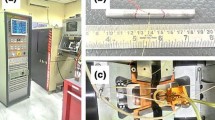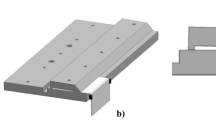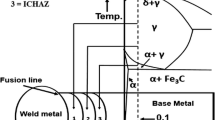Abstract
The austenite grain size (AGS) before decomposition is a crucial factor for the development of microstructure. However, this dependency is seldom discussed due to the difficulty of observing the grain growth of austenite during welding. In the current work, a grain growth algorithm is combined in a thermodynamics-based metallurgical model for the first time to analyse the influence of prior austenite grain size (pAGS). The phase volume fractions predicted at different cooling rates and pAGSs are compared with the experimental results of the continuous cooling transformation (CCT) diagram. To further investigate the influences of pAGS and microstructure on residual stress, experiments of bead-on-plate welding are conducted at three heat inputs, in which plates of S700 steel are operated by the arc welding process. The geometries after welding, chemical composition in the fusion zone (FZ) and the parameters of the double ellipsoidal heat source are calibrated using the software SimWeld. These geometries are imported to ABAQUS to create a Finite Element (FE) model. The validated metallurgical model together with the grain growth algorithm is implemented in the subroutine ABAMAIN to provide a thorough prediction of microstructure. With the knowledge of temperature and phase distributions, a coupled thermo-metallo-mechanical FE model is established to predict the residual stress distributions. The material properties are assigned by interpolating the individual phase property with its volume fraction. By comparing the results predicted by the model assuming constant pAGS, the influence of the pAGS on the residual stress is manifested. Moreover, simulations using overall material properties are also conducted. The stress distributions in the middle of plate surface are plotted along with the volume fractions of product phases to analyse the sensitivity of the residual stress to microstructure.













Similar content being viewed by others
References
Heinze C, Pittner A, Rethmeier M, Babu SS (2013) Dependency of martensite start temperature on prior austenite grain size and its influence on welding-induced residual stresses. Comput Mater Sci 69:251–260. https://doi.org/10.1016/j.commatsci.2012.11.058
Elmer JW, Palmer TA, Zhang W, Wood B, DebRoy T (2003) Kinetic modelling of phase transformation occurring in the HAZ of C-Mn steel welds based on direct observations. Acta Mater 51(15):4667–4668. (vol 51, pg 3333, 2003). https://doi.org/10.1016/S1359-6454(03)00357-4
Ashby MF, Easterling KE (1982) A 1st report on diagrams for grain-growth in welds. Acta Metall 30(11):1969–1978. https://doi.org/10.1016/0001-6160(82)90100-6
Andersen I, Grong O (1995) Analytical modeling of grain-growth in metals and alloys in the presence of growing and dissolving precipitates—1. Normal grain-growth. Acta Metall Mater 43(7):2673–2688. https://doi.org/10.1016/0956-7151(94)00488-4
Leblond JB, Devaux J (1984) A new kinetic model for anisothermal metallurgical transformations in steels including effect of austenite grain size. Acta Metall 32(1):137–146. https://doi.org/10.1016/0001-6160(84)90211-6
Jones SJ, Bhadeshia HKDH (1997) Kinetics of the simultaneous decomposition of austenite into several transformation products. Acta Mater 45(7):2911–2920. https://doi.org/10.1016/S1359-6454(96)00392-8
Takahashi M, Bhadeshia HKDH (1991) A model for the microstructure of some advanced bainitic steels. Mater Trans JIM 32(8):689–696
Khan SA, Bhadeshia HKDH (1990) Kinetics of martensitic-transformation in partially bainitic 300m steel. Mater Sci Eng A-Struct 129(2):257–272. https://doi.org/10.1016/0921-5093(90)90273-6
Rees GI, Bhadeshia HKDH (1992) Bainite transformation kinetics Parts1 Modified-model. Mater Sci Technol 8(11):985–993
Mi GY, Zhan XH, Wei YH, Ou WM, Gu C, Yu FY (2015) A thermal-metallurgical model of laser beam welding simulation for carbon steels. Model Simul Mater Sci Eng 23(3). https://doi.org/10.1088/0965-0393/23/3/035010
Collins DM, Conduit BD, Stone HJ, Hardy MC, Conduit GJ, Mitchell RJ (2013) Grain growth behaviour during near-γ′ solvus thermal exposures in a polycrystalline nickel-base superalloy. Acta Mater 61(9):3378–3391. https://doi.org/10.1016/j.actamat.2013.02.028
Garcin T, Militzer M, Poole WJ, Collins L (2016) Microstructure model for the heat-affected zone of X80 linepipe steel. Mater Sci Technol 32(7):708–721. https://doi.org/10.1080/02670836.2016.1142705
Francis JA, Bhadeshia HKDH, Withers PJ (2007) Welding residual stresses in ferritic power plant steels. Mater Sci Technol 23(9):1009–1020. https://doi.org/10.1179/174328407X213116
Lindgren LE (2001) Finite element modeling and simulation of welding. Part 1: increased complexity. J Therm Stresses 24(2):141–192. https://doi.org/10.1080/01495730150500442
Kirkaldy JS, Sharma RC (1982) A new phenomenology for steel it and CCT curves. Scr Metall 16(10):1193–1198. https://doi.org/10.1016/0036-9748(82)90095-3
Henwood C, Bibby M, Goldak J, Watt D (1988) Coupled transient heat-transfer—microstructure weld computations (part B). Acta Metall 36(11):3037–3046. https://doi.org/10.1016/0001-6160(88)90186-1
Ni JY, Wahab MA (2017) A numerical kinematic model of welding process for low carbon steels. Comput Struct 186:35–49. https://doi.org/10.1016/j.compstruc.2017.03.009
Deng D (2009) FEM prediction of welding residual stress and distortion in carbon steel considering phase transformation effects. Mater Des 30(2):359–366. https://doi.org/10.1016/j.matdes.2008.04.052
Deng D, Ma N, Murakawa H (2012) A computational approach on prediction of welding residual stress with considering solid-state phase transformations. Trans JWRI 2011:79–82
Borjesson L, Lindgren LE (2001) Simulation of multipass welding with simultaneous computation of material properties. J Eng Mater-T ASME 123(1):106–111
Nguyen-Xuan H, Liu GR, Bordas S, Natarajan S, Rabczuk T (2013) An adaptive singular ES-FEM for mechanics problems with singular field of arbitrary order. Comput Methods Appl Mech Eng 253:252–273. https://doi.org/10.1016/j.cma.2012.07.017
Nguyen HX, Nguyen TN, Abdel Wahab M, Bordas SPA, Nguyen-Xuan H, Vo TP (2017) A refined quasi-3D isogeometric analysis for functionally graded microplates based on the modified couple stress theory. Comput Methods Appl Mech Eng 313:904–940
Watt DF, Coon L, Bibby M, Goldak J, Henwood C (1988) An algorithm for modeling microstructural development in weld heat-affected zones (part A) reaction-kinetics. Acta Metall 36(11):3029–3035. https://doi.org/10.1016/0001-6160(88)90185-X
Cahn JW (1956) Transformation Kinetics during continuous cooling. Acta Metall 4(6):572–575. https://doi.org/10.1016/0001-6160(56)90158-4
Bhadeshia HKDH (1982) Thermodynamic analysis of isothermal transformation diagrams. Met Sci 16(3):159–165
Lee JL, Bhadeshia HKDH (1993) A methodology for the prediction of time-temperature transformation diagrams. Mater Sci Eng A-Struct 171(1–2):223–230. https://doi.org/10.1016/0921-5093(93)90409-8
DeHoff RT, Rhines FN (1968) Quantitative Microscopy. McGraw-Hill, pp 162–168
ASTM E112-13 (2013) Standard test methods for determining average grain size. ASTM International, West Conshohocken. https://doi.org/10.1520/E0112
Poorhaydari K, Patchett BM, Ivey DG (2005) Estimation of cooling rate in the welding of plates with intermediate thickness. Weld J 84(10):149s–155s
Alexandrov BT, Lippold JC (2006) In-situ weld metal continuous cooling transformation diagrams. Weld World 50(9):65–74. https://doi.org/10.1007/bf03263446
Cahn JW (1956) the kinetics of grain boundary nucleated reactions. Acta Metall 4(5):449–459. https://doi.org/10.1016/0001-6160(56)90041-4
Vu-Bac N, Lahmer T, Zhuang X, Nguyen-Thoi T, Rabczuk T (2016) A software framework for probabilistic sensitivity analysis for computationally expensive models. Adv Eng Softw 100:19–31. https://doi.org/10.1016/j.advengsoft.2016.06.005
Joshi S, Hildebrand J, Aloraier AS, Rabczuk T (2013) Characterization of material properties and heat source parameters in welding simulation of two overlapping beads on a substrate plate. Comput Mater Sci 69:559–565. https://doi.org/10.1016/j.commatsci.2012.11.029
Goldak JA, Akhlaghi M (2006) Computational welding mechanics. Springer Science & Business Media, Berlin, pp 30–32
Bhatti AA, Barsoum Z, Murakawa H, Barsoum I (2015) Influence of thermo-mechanical material properties of different steel grades on welding residual stresses and angular distortion. Mater Des 65:878–889. https://doi.org/10.1016/j.matdes.2014.10.019
Guo W, Francis JA, Li L, Vasileiou AN, Crowther D, Thompson A (2016) Residual stress distributions in laser and gas-metal-arc welded high-strength steel plates. Mater Sci Technol 32(14):1449–1461. https://doi.org/10.1080/02670836.2016.1175687
Totten GE (2002) Handbook of residual stress and deformation of steel. ASM International, USA
Masubuchi K (1980) Analysis of welded structures: residual stresses, distortion, and their consequences. Pergamon Press, Oxford, pp 191–192
Wei CH, Zhang J, Yang SL, Tao W, Wu FS, Xia WS (2015) Experiment-based regional characterization of HAZ mechanical properties for laser welding. Int J Adv Manuf Technol 78(9–12):1629–1640. https://doi.org/10.1007/s00170-014-6762-y
Acknowledgements
The authors would like to acknowledge the support from DeMoPreCI-MDT SIM SBO project.
Author information
Authors and Affiliations
Corresponding author
Additional information
Recommended for publication by Commission II - Arch Welding and Filler Metals
Rights and permissions
About this article
Cite this article
Ni, J., Vande Voorde, J., Antonissen, J. et al. Dependency of phase transformation on the prior austenite grain size and its influence on welding residual stress of S700 steel. Weld World 62, 699–712 (2018). https://doi.org/10.1007/s40194-018-0575-9
Received:
Accepted:
Published:
Issue Date:
DOI: https://doi.org/10.1007/s40194-018-0575-9




